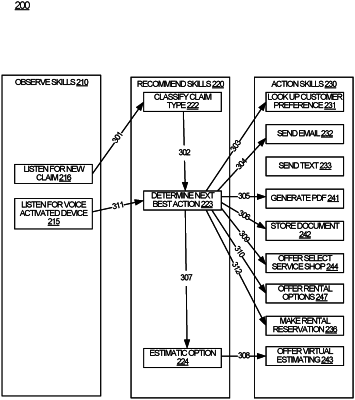| CPC G06Q 40/08 (2013.01) [G06F 40/30 (2020.01); G06N 20/00 (2019.01); G06Q 10/10 (2013.01)] | 17 Claims |

|
1. A computer-implemented method, comprising:
receiving, by a processor, first input data identifying an insurance claim;
determining, by the processor and based on the first input data, a claim type associated with the insurance claim;
receiving, by the processor, a voice input from a user device;
generating, by the processor inputting the voice input into a natural language parser, second input data related to at least one incomplete step of the insurance claim;
invoking, by the processor, a first machine learning model configured to:
identify, based at least in part on the second input data, an observed event associated with the insurance claim; and
select, based on the observed event, a second machine learning model trained to identify an action from a plurality of actions;
invoking, by the processor, the second machine learning model, wherein:
the second machine learning model is a neural network, and the processor trains the second machine learning model using supervised learning based on training data comprising:
sets of known values, each set of known values corresponding to a respective previously-processed insurance claim, and identifying a particular claim type characterizing the respective previously-processed insurance claim, and
for each of the previously-processed insurance claims, an indication of an action performed,
invoking the second machine learning model comprises providing the second input data and the claim type to the second machine learning model, and receiving output data generated by the second machine learning model based on the second input data and the claim type, and
the output data indicates a next action to be performed to process the insurance claim, the next action identifying information required by the at least one incomplete step of the insurance claim;
selecting, by the processor, a third machine learning model from a plurality of trained machine learning models, the third machine learning model being trained to perform the next action;
determining, by the processor, a confidence level associated with the performance of the next action by the third machine learning model;
invoking, by the processor and based on the confidence level being greater than a threshold, the third machine learning model to perform the next action using the second input data as input; and
updating, the second machine learning model, wherein the updating comprises training the second machine learning model based on the second input data and the performance of the next action by the third machine learning model.
|